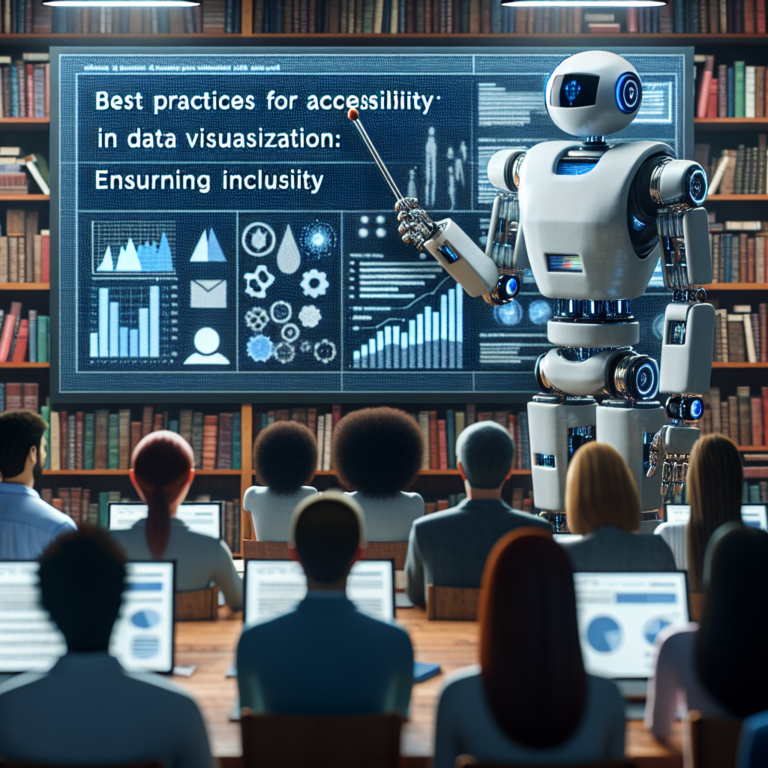1. Exploring the Basics of Large Data Visualization
Understanding the fundamentals of visualizing large data sets is crucial for anyone looking to effectively display vast amounts of information. This section delves into the core principles that underpin effective data visualization techniques, ensuring that even beginners can grasp the essential concepts.
Firstly, the importance of choosing the right visualization type cannot be overstated. Whether it’s a bar graph, line chart, heatmap, or scatter plot, each type serves a specific purpose and is suited to different kinds of data sets. For instance, heatmaps are excellent for visualizing complex data correlations across a two-dimensional layout, while line charts are ideal for showing changes over time.
Another fundamental aspect is the scalability of visualizations. As data sets grow, the visualization must remain comprehensible and informative. Techniques such as data aggregation and dynamic filtering help manage this scalability, allowing viewers to focus on relevant subsets of the data.
Lastly, the aesthetic design of data visualizations plays a significant role in their effectiveness. Simple design choices like color schemes and font sizes can greatly impact the readability and user engagement. It’s essential to strike a balance between aesthetic appeal and functionality to ensure that the visualization achieves its intended purpose.
By mastering these basic principles, you can begin to explore more complex data visualization techniques that can transform large data sets into insightful and compelling visual stories.
2. Key Tools and Software for Visualizing Large Data Sets
When tackling the challenge of visualizing large data sets, selecting the right tools and software is essential. This section highlights several key solutions that cater to diverse needs, from open-source platforms to sophisticated commercial software.
Open-source tools like Apache Superset and Plotly are popular among data professionals for their flexibility and cost-effectiveness. Apache Superset supports large-scale data exploration and visualization, offering features like customizable dashboards and SQL editors. Plotly, on the other hand, excels in creating interactive plots and offers extensive documentation to help users get started.
For those looking for more robust solutions, commercial software such as Tableau and Power BI provide powerful analytics capabilities. Tableau is renowned for its user-friendly interface and deep analytical possibilities, making it a favorite for enterprise-level data visualization. Power BI integrates seamlessly with existing Microsoft products, enhancing its appeal to organizations already embedded within the Microsoft ecosystem.
Each tool has its strengths, depending on the specific requirements of the data visualization task at hand. Factors to consider include the size of the data set, the complexity of the visualizations needed, and the user’s technical expertise. By carefully selecting the appropriate tool, you can maximize the impact of your data visualizations, turning large data sets into clear, insightful visual representations.
Ultimately, the choice of tool should align with your project’s goals, ensuring that it supports not only the visualization needs but also the scalability and security requirements of your data operations.
2.1. Open Source Tools
Open source tools are invaluable for visualizing large data sets due to their adaptability and community-driven enhancements. This section explores several prominent open source tools that are widely used in the field of data visualization.
Apache Superset stands out for its ability to handle large volumes of data. It offers features like customizable dashboards and an intuitive SQL editor, making it a top choice for data analysts. Another significant tool, Plotly, allows users to create interactive, publication-quality graphs online. Its API supports dozens of chart types and is designed with ease of use in mind.
GGplot2, part of the R programming environment, is celebrated for its sophisticated graphical capabilities and flexibility. It follows the grammar of graphics, allowing users to assemble graphs from a set of independent components. D3.js is another powerful tool, especially for web-based projects. It uses HTML, SVG, and CSS to bring data to life on the web, providing control over the final visual outcome.
These tools not only facilitate the effective visualization of complex data but also encourage innovation and customization through their open-source nature. By leveraging such tools, you can enhance your data presentations and uncover deeper insights from large data sets.
Choosing the right tool often depends on the specific needs of your project, including the complexity of data and the level of interactivity required. Open source tools provide a robust foundation for developing sophisticated visualizations and are a cornerstone in the toolkit of any data scientist.
2.2. Commercial Visualization Software
Commercial visualization software offers robust features and dedicated support, making them ideal for enterprises handling large data sets. This section covers some of the leading commercial tools in the market.
Tableau is renowned for its intuitive drag-and-drop interface that allows users to quickly create complex visualizations. It supports a wide range of visual styles and is highly scalable, suitable for both small and large businesses. Power BI, Microsoft’s analytics service, provides strong integration with other Microsoft products, making it a preferred choice for many corporate environments.
Another significant player, SAS Visual Analytics, offers advanced analytics with an emphasis on usability and data interaction. It is designed to handle large volumes of data and complex analytics without compromising on performance.
These tools are not just about visualizing data but also about enabling decision-makers to derive actionable insights with ease. The choice of software often depends on specific business needs, including integration capabilities, scalability, and the level of analytical depth required.
Investing in the right commercial software can dramatically enhance your organization’s ability to interpret and act on large volumes of data, turning raw data into a strategic asset.
3. Innovative Techniques in Data Visualization
Innovative techniques in data visualization are transforming how we understand and interact with large data sets. This section explores cutting-edge methods that enhance the clarity and impact of data visualizations.
One such technique is the use of augmented reality (AR) to create immersive data experiences. AR allows users to visualize data in three-dimensional space, offering a more intuitive understanding of complex information. For example, using AR, urban planners can visualize city data overlaid on the actual cityscape, making it easier to interpret and utilize.
Another innovative approach involves the use of machine learning algorithms to automate the creation of visualizations. These algorithms can analyze large volumes of data and generate visual representations that highlight important trends and anomalies without human intervention.
Storytelling with data is also gaining traction. This technique involves crafting a narrative around the data, using visualizations to drive the story forward. This method not only makes the data more relatable but also more memorable, as it connects with viewers on an emotional level.
These innovative techniques not only make data more accessible but also more engaging, allowing users to gain deeper insights and make more informed decisions based on complex data sets.
3.1. Interactive Visualizations
Interactive visualizations are pivotal in enhancing user engagement and understanding of large data sets. This section explores how interactivity transforms data visualization.
Interactive tools allow users to delve deeper into the data by filtering, sorting, and examining specific aspects on demand. Tools like D3.js provide extensive capabilities for creating dynamic, browser-based visualizations that respond to user inputs. This not only makes the data more accessible but also allows users to explore data layers at their own pace.
Another key aspect of interactive visualizations is their ability to adapt to different user actions. For example, a dashboard might display general trends at first glance but can quickly zoom into granular data when a user selects a specific area or category. This adaptability makes interactive visualizations incredibly powerful for data-driven decision-making.
By integrating these interactive elements, data scientists and analysts can create more meaningful and actionable visualizations that cater to diverse user needs, enhancing the overall utility of the data.
3.2. Real-time Data Visualization
Real-time data visualization is essential for dynamic decision-making in fast-paced environments. This section discusses how real-time visualization empowers organizations to act swiftly and effectively.
Technologies like streaming APIs and WebSocket facilitate the continuous flow of data, enabling visualizations that update instantaneously. These technologies are crucial in sectors like finance and healthcare, where conditions change rapidly and require immediate response. For example, financial dashboards that track live market data allow traders to make informed decisions based on the latest trends.
Another key component is the use of efficient back-end systems that can process and visualize data without lag. This involves optimizing data pipelines and storage solutions to handle high-velocity data streams effectively. Tools such as Apache Kafka and Elasticsearch are often employed to manage these data flows, ensuring that the visualizations are both accurate and timely.
By integrating these technologies, organizations can create powerful real-time data visualizations that not only provide a snapshot of current conditions but also enable proactive management of operations and resources.
4. Case Studies: Success Stories of Large Data Visualization
Examining real-world applications of data visualization techniques can provide valuable insights into the practical benefits and challenges of visualizing large data sets. This section highlights several success stories across different industries.
In healthcare, data visualization has played a crucial role in tracking disease outbreaks and patient data. For example, interactive dashboards were used extensively during the COVID-19 pandemic to monitor real-time data on infection rates, recovery, and vaccination progress. These visualizations helped public health officials make informed decisions quickly.
In the finance sector, large data visualization techniques have revolutionized how data is analyzed and presented. Financial institutions use complex visualizations to track real-time market conditions, analyze trends, and make predictive analyses. This enables traders and analysts to respond more effectively to market changes.
Another notable example comes from the retail industry, where large-scale data visualizations assist in managing vast amounts of consumer data to enhance marketing strategies. Retail giants integrate customer purchase data with geographic information systems (GIS) to create heat maps of consumer activity. This helps in optimizing store placements and targeted advertising.
These case studies demonstrate the transformative power of effective data visualization in managing large data sets, providing actionable insights, and driving strategic decision-making across various sectors.
5. Best Practices for Effective Data Visualization
To ensure that your efforts in visualizing large data are successful, adhering to established best practices is crucial. This section outlines essential strategies to enhance the clarity and impact of your data visualizations.
Simplicity is Key: Start by keeping your visualizations simple. Overcomplicated charts can confuse rather than clarify. Use clean, uncluttered layouts and limit the use of colors to those that provide clear, meaningful distinctions between data points.
Consistency Matters: Consistency in design ensures that once users learn to read your charts, they can easily understand new ones. Apply the same set of design rules across all visualizations, such as consistent color schemes, typography, and scale.
Highlight Important Data: Make sure to direct the viewer’s attention to the most important data. Techniques like highlighting, annotation, or using dynamic elements can help emphasize key information without overwhelming the user.
Responsive Design: With the variety of devices available today, ensure your visualizations are responsive. They should be easily interpretable on any device, from desktops to smartphones, enhancing accessibility and user experience.
Use the Right Tool: Choose the right tool for the job. Different tools have strengths in different areas; some are better suited for real-time data, others for static reporting. Selecting the appropriate tool can make a significant difference in the effectiveness of your visualizations.
By following these best practices, you can create data visualizations that are not only visually appealing but also serve their primary function of making large data sets comprehensible and actionable.
6. Future Trends in Visualizing Large Data
The landscape of data visualization techniques is rapidly evolving, driven by technological advancements and increasing data complexity. This section explores the emerging trends that are shaping the future of visualizing large data sets.
Augmented Reality (AR) and Virtual Reality (VR): AR and VR are set to transform how we interact with data. By integrating data visualization into three-dimensional spaces, these technologies allow users to engage with data in more intuitive and immersive ways. For example, VR can simulate real-world environments for spatial data analysis, enhancing the understanding of geographical and architectural data.
Artificial Intelligence (AI) in Visualization: AI is increasingly being used to automate the creation of visualizations and to provide insights that are too complex for manual discovery. AI algorithms can detect patterns and anomalies in large data sets and suggest the most effective visualization types for those patterns.
Increased Emphasis on Collaborative Visualization: As remote work becomes more prevalent, tools that support collaborative visualization will become crucial. These tools will allow teams to work together on visualizations in real time, regardless of their physical location, enhancing decision-making processes across different sectors.
Advancements in Real-time Data Visualization: The demand for real-time data processing and visualization is growing. Future tools will likely focus on improving the speed and efficiency of visualizing live data streams, which is essential for sectors like finance, healthcare, and manufacturing where timely data is critical.
By staying informed about these trends, you can prepare to adopt the next generation of tools and techniques for visualizing large data, ensuring that your visualizations remain effective and relevant in a rapidly changing digital landscape.



